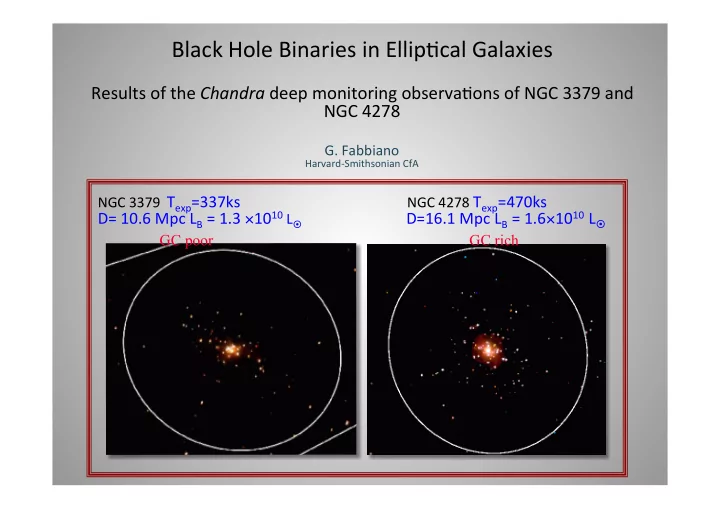

Black Hole Binaries in Ellip0cal Galaxies Results of the Chandra deep monitoring observa0ons of NGC 3379 and NGC 4278 G. Fabbiano Harvard‐Smithsonian CfA NGC 3379 T exp =337ks NGC 4278 T exp =470ks D= 10.6 Mpc L B = 1.3 × 10 10 L D=16.1 Mpc L B = 1.6 × 10 10 L GC poor GC rich
Galac0c BHBs and their spectral states Remillard & McClintock 2006
Do we see similar spectral states in extragalac0c LMXBs as in Galac0c BHBs? NGC 3379 – Brassington et al 2010 (submiXed) NGC 4278 – Fabbiano et al 2010 (submiXed) Nicky Brassington
‘Biases’ in spectral results Brassington et al 2010 Galac0c BHB spectra are typically well represented with 2 • components, with varying flux ra0o: power‐law and accre0on disk The sta0s0cs of LMXB detec0ons do not give us enough counts to • aXempt a two component spectral fit What can we learn from the results of fi`ng these data with single • component? Either power‐law or DBB? We ran extensive simula0ons that show we can learn from these • simple fit results 1. MCD +PO simulated spectra 2. kT range: 0.5 – 2.25 keV in steps of 0.25 keV 3. Γ range: 1.5 ‐2.3 in steps of 0.2 4. Flux ra0os of two components range: 0% ‐ 100% 5. Spectra simulated with 1000 (and 500) counts 6. 100 spectra generated for each combina0on of parameters
‘Biases’ in spectral results N H vs. Disk/total in Power‐law only fit Brassington et al 2010 Effect of fi`ng a power‐ law+ disk spectrum with no intrinsic N H (only Galac0c) with a single power‐law model solid lines, Γ=1.7 Best fit N H > N H Gal. Greater ‘apparent ‘ N H for increasingly greater disk components N H Gal.
‘Biases’ in spectral results – N H vs. PO/total in Disk only fit Brassington et al 2010 Effect of fi`ng a power‐ law+ disk spectrum with N H Gal. no intrinsic N H (only Galac0c) with a single ‘Disk’ model Best fit N H < N H Gal. If spectrum includes a PO component Similar dependence for a range of kT in ~0.5 – 2.2 keV
The simula0ons show that fi`ng a disk + power‐law spectrum with: Single power‐law N H >N H Gal. Single disk (kT~ 1‐2 KeV) N H <N H Gal. The effect is stronger for larger frac0on of second component
NGC 3379 ‐ examples of variable BHB Candidates Brassington et al 2010 ‐ submiXed d l e i F ? G C
NGC 3379 – S86 (Field) N H Gal Disk 2 σ 2+4 1+3 Power‐law
NGC 3379 – S42 (GC) N H Gal 1+3 Disk 2 σ 2+4 Power‐law
NGC 3379 – S102 cool disk? N H Gal N H Gal
NGC 3379 – S102 ‐ cool disk? T in ‐N H T in ‐ Γ
BHB Candidates in NGC 3379 & NGC 4278 NGC 3379 Source 74 A 20 Msol BH?
Spectra of LMXBs in NGC 4278 Lenta0 et al., AAS; Fabbiano et al 2010 • Squares – GC‐LMXBs Circles – Field‐LMXBs (see Brassington et al 2009) • Red ‐ > 1 x 10 38 erg/s Yellow – 1x10 37 ‐1x 10 38 erg/s
Comparison of ‘average’ Field LMXB spectra L X > 1.5×10 38 erg s ‐1 spectrum is Disk dominated L X < 1.5×10 38 erg s ‐1 spectrum is Power‐Law dominated Power‐law fits Disk fits Γ kT in N H Gal N H N H
Comparison of ‘average’ GC and Field BHB Candidate spectra GC Power‐law fits Disk fits kT in Γ FIELD GC High Lx GC N H Gal N H N H • High luminosity field and GC spectra are consistent with each other • Low‐luminosity (<6 10 37 erg/s) GC spectra are either more absorbed power‐law or cooler disks
Is Ellip0cal ‘rejuvena0on’ linked with BHB produc0on? ‘young’ (Kim & Fabbiano ‘young’ ‘old’ 2010, ApJ submiXed) Frac0on of LMXBs with L X >5x10 38 erg/s ‘old’
Summary • Luminous LMXBs in Ellip0cal Galaxies behave like BHBs • In the cases where the spectrum appears disk‐dominated • most sources are consistent with the L X ‐ T in rela0on of 5‐10 M BHs • there is one case sugges0ng a 20 M BH • there is one case of cool disk – ouxlow? Comptoniza0on? Big BH? • We find differences in the spectra of Field and GC LMXBs with L X < 6x10 37 erg/s • Galaxy ‘rejuvena0on’ is correlated with an increased frac0on of luminous BHBs (> 5x10 58 erg/s)
What is this? …. Not the eye of Sauron A free drink for the first right answer See Junfeng Wang
Luminous LMXBs in NGC 3379 How do they compare with Galac0c BHB? Source 74 A 20 Msol BH?
Summary • Luminous LMXBs in Ellip0cal Galaxies behave like BHBs • In the cases where the spectrum appears disk‐dominated • most sources are consistent with the L X ‐ T in rela0on of 5‐10 M BHs • there is one case sugges0ng a 20 M BH • there is one case of cool disk – ouxlow? Comptoniza0on? Big BH? • We find differences in the spectra of Field and GC LMXBs with L X < 6x10 37 erg/s
Recommend
More recommend